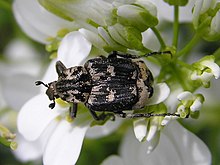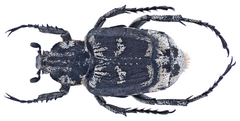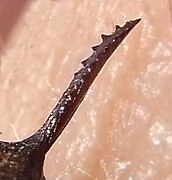|
Valgus hemipterus
Valgus hemipterus is a smallish species of scarab beetle (family Scarabaeidae) found in the Northern Hemisphere. SubspeciesSubspecies include:[1]
DistributionThis species occurs from the Caucasus and Turkey to North Africa and southern and central Europe (Albania, Austria, Belarus, Belgium, Bosnia and Herzegovina, Bulgaria, Central European Russia, Croatia, Cyprus, Czech Republic, Denmark, European Turkey, France, Germany, Greece, Hungary, Italy, Latvia, Lithuania, Luxembourg, Republic of North Macedonia, Northwest European Russia, Poland, Portugal, Romania, Slovakia, Slovenia, South European Russia, Spain, Switzerland, The Netherlands, Ukraine, Yugoslavia). The species has been introduced to the Nearctic realm,[2] in parts of North America, especially Ontario, Michigan and Ohio. DescriptionThis species reaches a body length of 6–10 mm.[3] The basic color is black or dark brown. The scales on the body of the male are dark brown with a light pattern, while most scales in females are dark. Pronotum is rather serrate along lateral edges, a transverse medial ridges is not well developed and basal margin is quite rounded.[4] The elytrae are shortened and do not cover the entire body. Pronotum and elytra show patches of light-colored setae.[4] Females bear a striking long acuminate telson - unusual fact in Coleoptera - with a central groove near apex and irregular lateral serrations, which makes them easily distinguishable from the males. In addition, The males have a different drawing than the females.[3] BiologyThese beetles, which can be found from May to June[3] on flowers or wood, are relatively common. The species has one generation (univoltine) and hibernates as a pupa.[3] Adult females usually oviposit to moist, rotting wood and use their acuminate telson to create the site of oviposition.[4] The larvae live in the soil[3] and feed on dead wood of birch and other trees. Gallery
Bibliography
References
External linksWikispecies has information related to Valgus hemipterus. Wikimedia Commons has media related to Valgus hemipterus.
|
||||||||||||||||||||||||||||||||||||||||
Portal di Ensiklopedia Dunia




